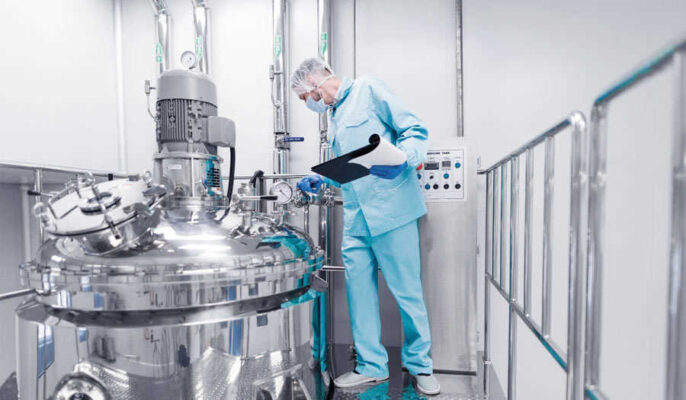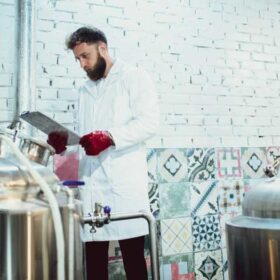Are you an aspiring brewer looking to take your craft to the next level? Are you considering expanding your brewery’s production capacity to meet the increasing demand for your exceptional brews? If so, the 5bbl brewing system might be the perfect solution for you. In this article, we will delve into the intricacies of the 5bbl brewing system, exploring its components, benefits, setup, operation, maintenance, and more. So, grab your favorite brew and let’s embark on this journey of brewing excellence!
Understanding the Components of a 5bbl Brewing System
To truly comprehend the capabilities and functionality of a 5bbl brewing system, it’s essential to familiarize yourself with its core components. Here are the key elements that make up a 5bbl brewing system:
Mash Tun
The mash tun serves as the vessel where mashing takes place. It provides an environment for mixing hot water and malted grains to initiate enzymatic reactions and extract sugars. With a 5bbl brewing system, the mash tun has a capacity of 5 barrels, allowing for the production of large volumes of wort.
Brew Kettle
The brew kettle, also known as the boiling kettle, is where the wort is boiled and hops are added to achieve bitterness, flavor, and aroma. In a 5bbl brewing system, the brew kettle accommodates the entire batch, ensuring efficient boiling and hop utilization.
Fermenter
After the wort is cooled, it is transferred to the fermenter, where yeast is added to initiate fermentation. The fermenter provides an environment for the yeast to convert sugars into alcohol and produce the desired flavors and aromas. A 5bbl brewing system typically includes fermenters with a capacity of 5 barrels or more.
Bright Tank
Once fermentation is complete, the beer is often transferred to a bright tank for conditioning and clarification. The bright tank allows for further settling of solids and the removal of any remaining yeast or impurities. In a 5bbl brewing system, the bright tank capacity matches the brewing capacity to ensure a smooth transition between the fermentation and packaging stages.
Cooling System
A reliable cooling system is crucial for maintaining optimal temperatures throughout the brewing process. It ensures proper cooling of the wort after boiling and controls the temperature during fermentation. A 5bbl brewing system incorporates an efficient cooling system to achieve desired temperature profiles and maintain the quality of the beer.
Control Panel
The control panel serves as the nerve center of a 5bbl brewing system. It allows brewers to monitor and regulate various parameters such as temperature, pressure, and flow rates. The control panel ensures precise control over the brewing process, enabling brewers to achieve consistency and repeatability in their beer production.
By understanding these components, brewers can grasp the interplay between each element and how they contribute to the overall brewing process. With a solid understanding of the components, brewers can harness the capabilities of a 5bbl brewing system to create exceptional beers with consistency and precision.

Benefits of a 5bbl Brewing System
Investing in a 5bbl brewing system offers numerous advantages for breweries seeking growth and efficiency. Let’s explore some of the key benefits:
Scalability
A 5bbl brewing system provides a significant increase in production capacity compared to smaller systems. This scalability allows breweries to meet rising demand without compromising on quality or the ability to experiment with new recipes. Whether you’re starting small and planning for future growth or looking to expand an existing operation, a 5bbl system offers the capacity to scale up your production.
Efficiency
With a larger brewing system like the 5bbl, breweries can achieve economies of scale and streamline their production processes. The larger batch sizes allow for more efficient utilization of resources such as time, energy, and raw materials. By producing larger volumes of beer in a single batch, breweries can reduce the labor and cleaning costs per unit of beer produced. This increased efficiency contributes to improved profitability and overall operational effectiveness.
Quality Control
Maintaining consistency and ensuring high-quality beer is crucial for the success of any brewery. A 5bbl brewing system empowers brewers to exercise tighter control over critical brewing parameters. From mash temperatures to fermentation conditions, the larger system provides greater precision and stability, resulting in more consistent and reproducible beer. This enhanced control over the brewing process enables brewers to meet customer expectations and build a strong reputation for their brand.
Cost-effectiveness
While the initial investment in a 5bbl brewing system may be higher than smaller systems, it offers long-term cost advantages. The larger batch sizes and increased production capacity contribute to lower production costs per unit of beer. By producing more beer in each batch, breweries can achieve economies of scale and reduce overhead costs. Additionally, having a 5bbl system allows breweries to meet growing demand, minimizing the risk of losing customers or missing out on business opportunities.
Flexibility
One of the notable advantages of a 5bbl brewing system is the flexibility it offers. Breweries can utilize the increased capacity to produce a wide range of beer styles and experiment with new recipes. The ability to cater to diverse consumer preferences and adapt to market trends is crucial for staying competitive in the craft beer industry. With a 5bbl system, breweries can easily produce seasonal or limited-edition beers alongside their core offerings, providing variety and excitement to their customers.
In conclusion, investing in a 5bbl brewing system brings scalability, efficiency, quality control, cost-effectiveness, and flexibility to breweries. It empowers brewers to meet growing demand, optimize their production processes, ensure consistent quality, reduce costs, and offer a diverse range of beers. By harnessing the benefits of a 5bbl system, breweries can position themselves for success and growth in the dynamic and competitive craft beer market.
Setting up a 5bbl Brewing System
Before diving into the world of 5bbl brewing, it’s essential to consider the necessary preparations and setup requirements. Here are some key factors to keep in mind:
Space and Layout Requirements
A 5bbl brewing system requires a dedicated space that can accommodate the brewing equipment, fermentation vessels, and storage areas. When planning the layout, consider the footprint of each component and ensure there is ample space for movement, cleaning, and maintenance activities. Take into account the size of the brewhouse, fermenters, bright tanks, and any additional equipment or accessories. It’s important to have enough room for brewers to work efficiently and safely, as well as space to store raw materials, finished beer, and cleaning supplies.
Equipment Installation and Setup
Setting up a 5bbl brewing system involves assembling and installing various components. Follow the manufacturer’s instructions carefully to ensure proper installation. This includes connecting pipes, valves, and fittings according to the designated configuration. It’s essential to pay attention to the correct placement and alignment of equipment to ensure smooth and efficient workflow during brewing operations. Properly secure the equipment to the floor or appropriate support structures to prevent accidents or damage during operation.
Plumbing and Electrical Considerations
Adequate plumbing and electrical systems are crucial for the proper functioning of a 5bbl brewing system. Consult with professionals, such as plumbers and electricians, to ensure that the plumbing infrastructure can handle the required water supply, drainage, and wastewater disposal. The plumbing system should be designed to accommodate the flow rates and pressures necessary for brewing operations. Similarly, work with electricians to ensure that the electrical setup meets the system’s power requirements and complies with safety standards. This includes proper wiring, circuit protection, and grounding to prevent electrical hazards. It’s important to have the electrical capacity to power all the brewing equipment and control panels without overloading the system.
Safety and Compliance Measures
Brewing involves handling potentially hazardous materials, such as hot liquids and chemicals. Implement safety measures to protect personnel and adhere to regulatory requirements. Provide appropriate safety equipment, such as heat-resistant gloves, goggles, and safety shoes, to ensure the safety of the brewing team. Implement standard operating procedures for handling equipment, working with hot liquids, and managing chemicals. Conduct regular safety training sessions to educate the brewing staff on safe practices and emergency procedures. Additionally, ensure compliance with local health and safety regulations and obtain any necessary permits or licenses required to operate a brewery. It’s important to prioritize the well-being of the team and ensure a safe working environment.
By considering these factors and addressing them during the setup of your 5bbl brewing system, you can lay a solid foundation for a safe, efficient, and successful brewing operation. Proper planning and attention to detail will contribute to a smooth workflow and allow you to focus on creating exceptional beers with your new 5bbl brewing system.
Operating a 5bbl Brewing System
Once your 5bbl brewing system is set up, it’s time to put it into action. Operating the system effectively requires careful planning and adherence to established brewing practices. Let’s explore the key steps involved:
Recipe Formulation and Ingredient Preparation
Start by formulating recipes that align with your brewery’s brand and target market. Consider the ingredients, including malt, hops, yeast, and adjuncts, to achieve the desired flavor profiles. Research different malts and hops to understand their characteristics and how they contribute to the overall beer flavor. Create a detailed recipe that specifies ingredient quantities and brewing instructions. Ensure accurate measurements and proper ingredient preparation to maintain consistency in your brews.
Mashing and Boiling Process
Transfer the measured grains into the mash tun and mix them with hot water to initiate the mashing process. Maintain the required temperature and duration for enzymatic activity, typically in the range of 148°F to 158°F (64°C to 70°C). Stir the mash to ensure even temperature distribution and efficient enzymatic conversion. After mashing, transfer the resulting liquid, known as wort, to the brew kettle for boiling. Bring the wort to a vigorous boil and add hops at specific intervals according to your recipe. This hop addition process determines the bitterness, flavor, and aroma of the beer. Maintain the boil for the desired duration, usually between 60 to 90 minutes.
Fermentation and Conditioning
Once the wort is boiled and cooled, transfer it to the fermenter and pitch the appropriate yeast strain. Ensure proper yeast rehydration or yeast starter preparation as per the manufacturer’s instructions. Maintain optimal fermentation conditions, including temperature and oxygen levels, to allow the yeast to convert sugars into alcohol. Monitor the progress of fermentation by regularly measuring the specific gravity using a hydrometer or refractometer. Adjust temperature and provide necessary nutrients to the yeast as needed. After primary fermentation, transfer the beer to the bright tank for conditioning and further clarification. Allow the beer to settle and clarify, often for a period of several days to weeks, depending on the beer style.
Carbonation and Packaging
Before packaging, determine the desired carbonation level for your beer. You can achieve carbonation through natural carbonation by adding a calculated amount of priming sugar to the beer before bottling or kegging. Alternatively, you can employ forced carbonation methods using a carbonation stone or carbonation system. Ensure proper cleaning and sanitization of the packaging materials, such as kegs, cans, or bottles, to maintain the quality of the final product. Fill the containers carefully, avoiding excessive oxygen exposure. Seal and label the containers, readying them for distribution or consumption.
By following these operating procedures, you can utilize your 5bbl brewing system to produce high-quality beer. Adhering to established brewing practices, maintaining cleanliness and sanitation, and monitoring fermentation progress will help you create consistent and delicious brews that will satisfy beer enthusiasts.
Maintenance and Cleaning of a 5bbl Brewing System
Regular maintenance and cleaning are essential for the longevity and optimal performance of your 5bbl brewing system. Here are some key aspects to consider:
Regular Maintenance Procedures
Follow the manufacturer’s guidelines for routine maintenance tasks to ensure the smooth operation of your brewing system. This may include inspecting and lubricating moving parts, such as pumps and agitators, checking seals and gaskets for wear or leaks, and monitoring pressure and temperature gauges for accuracy. Regularly calibrate equipment to maintain precise measurements and functionality. It’s important to address any issues promptly and perform necessary repairs or replacements to prevent potential breakdowns during brewing operations.
Cleaning and Sanitization Practices
Maintain strict cleaning and sanitization protocols to prevent contamination and off-flavors in your beer. Develop a cleaning schedule that includes thorough cleaning of all vessels, pipelines, and equipment after each batch. Use appropriate cleaning agents and sanitizers recommended for brewery applications. Pay special attention to areas that come into direct contact with the beer, such as fermenters, bright tanks, and kegs. Ensure thorough cleaning of heat exchangers, filters, and other critical components to remove any buildup or debris that can impact the efficiency of your brewing system.
Troubleshooting Common Issues
Familiarize yourself with common issues that can arise during brewing operations and develop troubleshooting procedures to address them promptly. Temperature fluctuations, pump failures, clogged lines, or leaks are some examples of issues that may occur. Regularly inspect and clean heat exchangers to prevent blockages and ensure efficient heat transfer. Clean and replace filters to maintain proper filtration and prevent any contamination. Keep spare parts and tools on hand to facilitate quick repairs and minimize downtime. Regularly monitor the performance of your brewing system and address any deviations or anomalies to maintain consistent and high-quality beer production.
By adhering to regular maintenance procedures, implementing effective cleaning and sanitization practices, and promptly addressing any issues or troubleshooting common problems, you can ensure the longevity and optimal performance of your 5bbl brewing system. Consistent maintenance and cleaning practices contribute to the production of high-quality beer and help maintain the efficiency of your brewing operations.
Tips for Maximizing the Efficiency of a 5bbl Brewing System
To make the most of your 5bbl brewing system, consider implementing the following tips:
Workflow Optimization
Streamline your brewing process by optimizing the workflow. Identify any bottlenecks or areas of inefficiency and find ways to improve them. This may involve rearranging the layout of your brewing space to create a more efficient and ergonomic workspace. Standardize procedures and create a step-by-step workflow that minimizes unnecessary movements and maximizes productivity. By optimizing your workflow, you can save time, reduce errors, and increase overall efficiency in your brewing operations.
Quality Assurance Measures
Maintain rigorous quality control procedures throughout the brewing process. Implement quality assurance checks at each stage to ensure the highest standards of beer production. Monitor gravity, pH levels, and conduct sensory evaluations to ensure consistency and quality in your brews. Document and analyze data to identify any trends or deviations and take corrective actions as needed. By maintaining a strong focus on quality, you can ensure that every batch of beer meets or exceeds customer expectations.
Batch Scheduling and Planning
Develop a well-structured batch scheduling and planning system to optimize production efficiency. Consider factors such as fermentation and conditioning times, ingredient availability, and packaging requirements. By carefully scheduling and planning your batches, you can minimize downtime and maximize the utilization of your 5bbl brewing system. This will help you achieve a steady production flow, reduce waiting times between batches, and ensure that you are meeting customer demands effectively.
Equipment Upgrades and Enhancements
Stay informed about the latest advancements in brewing technology and equipment. Periodically assess your brewing system for potential upgrades or enhancements that can improve efficiency, quality, or expand your capabilities. For example, investing in automated controls can help you streamline your brewing processes and reduce the risk of human error. Energy-efficient components can help you save on utilities and operating costs. Advanced monitoring systems can provide real-time data and insights to optimize brewing parameters. By staying up-to-date with the latest technology, you can maximize the efficiency and effectiveness of your 5bbl brewing system.
By implementing these tips, you can maximize the efficiency of your 5bbl brewing system, increase productivity, and ensure the production of high-quality beer. Continuously evaluate your processes, invest in necessary upgrades, and prioritize quality to drive the success of your brewery.
Conclusion
The 5bbl brewing system opens up exciting opportunities for brewers looking to expand their production capacity and take their craft to new heights. With its larger batch sizes, scalability, and improved control, this system empowers breweries to meet growing demand while maintaining consistency and quality. By understanding the components, benefits, setup, operation, and maintenance of a 5bbl brewing system, you can embark on a journey of brewing excellence and delight beer enthusiasts with your exceptional brews.






